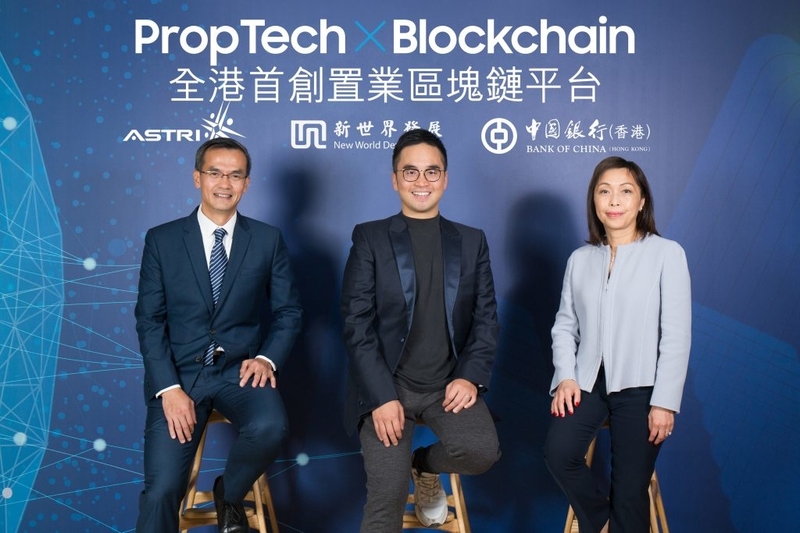
According to a recent press release, with Hong Kong Applied Science and Technology Research Institute Company Limited (ASTRI) and an investment holding company announced the creation of Hong Kong’s first property-purchase Blockchain platform.
The two also partnered with the Bank of China (Hong Kong) (BOCHK), which is the first bank to participate and apply the new platform to its services.
Advanced blockchain technology allows the platform to provide an all-in-one support service to buyers, banks and related bodies.
With the collaboration, PropTech (Property Technology) is the breakthrough that will fundamentally reshape Hong Kong’s real estate industry, saving time and resources in the property-buying process. First-time buyers will soon enjoy a fast and convenient user experience in the new era of Property-Purchase 2.0, coming on-stream in the second quarter of 2019.
Building on the success of FinTech in the financial sector, PropTech heralds a revolution in Hong Kong’s real estate industry.
The new PropTech platform seeks to open up the entire real estate industry chain; it also marks the first implementation of Blockchain technology into the real estate industry. The platform is a landmark in revolutionising the traditional model while remaining fully in sync with the government’s vision in creating a smart city and a new era of PropTech.
This project leverages blockchain technology and relies on PropTech as a strong boost to the innovation-led growth of Hong Kong’s property sector. It will help to enhance the operational efficiency of developers, bring convenience and security to consumers and benefit the entire ecosystem of the property sector.
The technology, which is the first property-purchase blockchain platform in Hong Kong, will help to enhance the customer experience by offering seamless integration of mortgage services in the bank’s customers’ property purchase journey, according to the Deputy Chief Executive of the partnering bank.
The revolutionary advantage of integrating Blockchain technology into the property-buying platform is that it allows an unprecedented reduction of time and work between signing the provisional agreement and finalising the deal.
The one-stop Blockchain platform can save up to eight hours in a transaction by integrating all the time-consuming intermediary steps: the filling-in of long and complex application documents, the tedious back-and-forth between banks and lawyers, and the time-consuming research into information about mortgage loans.
Moreover, the one-stop platform benefits to service providers and saves around 47 hours of work. The entire industry chain will save around 55 hours in total.
Key Advantages of Combining PropTech and Blockchain Technology
- 24/7 Streamlined Service with no Restrictions on Time or Location
With the aid of the new high-end encrypted network, buyers, property developers, banks and related bodies will break away from traditional procedures and will benefit from the seamless integration of each element in the whole industry chain.
Buyers will be able to enjoy a much faster and more user-friendly service with easy access to all information, also benefitting from regular status updates on mortgage applications and procedures.
- Saving Six Hours in Mortgage Application Procedures
First-time buyers are usually directly involved in comparing mortgage proposals from at least four banks, a process which requires repetitive, complex and extensive paperwork. The Blockchain platform will send the purchaser’s authorised, encrypted and digitally signed provisional agreement to the selected banks, saving buyers at least six hours of following up with the different banks, and thus dramatically shortening the time spent in the application process.
- Instant Intelligence – Keeping Buyers on Track
First-time buyers have to sign legal documents and complete payments in a given time-frame. It is easy to miss transfer deadlines or leave out certain steps, and this can lead to unnecessary loss and delay. Buyers also need to follow up with lawyers to get updates on status, each transaction needing at least 15 phone calls on average, thus resulting in considerable inconvenience to buyers.
The Blockchain platform incorporates procedural notifications to remind buyers of important dates such as the settlement of deposits, key agreement dates, and final submission of formal paperwork. The new platform allows a brand-new hassle-free purchase experience for all customers, where buyers can easily access instant updates and relevant information, saving around two hours during the process.
- Quick Digital Verification of Buyer’s Information
Under the old model, developers, banks and related bodies each needed to input the buyers’ information and verify it manually and separately. All information required painstaking input and verification by hand. But in the new system, buyers can authorise banks and related bodies to access their securely encrypted information through the Blockchain platform. This can drastically reduce time and procedures, making the process far more efficient.
- Environmentally Friendly and Paperless Procedures
In the past, whether for a bank mortgage application, a lawyer’s preparatory document, or a developer’s progress report, if buyers were applying for mortgages with four different banks, it was necessary to print a large number of documents involving at least 120 sheets of paper. With the introduction of the Blockchain platform, all parties can reduce unnecessary document printing, and the entire process becomes far more environmentally friendly while saving precious time and resources.
Safe and Reliable Blockchain Technology
Blockchain is an innovative technology. It utilises a distributed system to verify each transaction so that transfers are guaranteed to be safe and secure. Information held on a Blockchain exists as a database, shared by buyers, sellers, banks and lawyers. The records are truly public, transparent and traceable so it is difficult for a transaction record to be corrupted. Information security is thereby greatly enhanced.
















